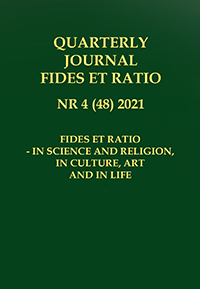Abstract
The article analyzes the relationship of press and Internet use by young adults or, according to Arnett's approach, those entering adulthood, with their level of religiosity. The context for the correlation studied was the identity styles of the subjects and the religiosity of their parents, or rather the subjects' perceived level of this religiosity expressed as a score on the Huber C-15 Scale. Religiosity can be characterized as a multidimensional structure that includes five representative, common, and relatively autonomous dimensions: experiential, ritualistic, ideological, intellectual, and consequential of religiosity. Young adults often represent a synthetic-conventional faith, which is strongly associated with authority figures and community. At this stage, religiosity is not yet fully internalized, so it fluctuates easily. The greatest influence on the level of religiosity seems to be the parents’ religiosity. At the same time, people representing the discussed age group are among the most engaged users of new media, which may also impinge on their faith. Polish studies proved that containing criticism of the Church and exposing its flaws may have a negative impact on the religiosity of the recipients. The study was conducted using a questionnaire prepared by M. Kutt and tools that have an established position in research practice (Berzonky's Identity Styles Questionnaire and the C-15 Huber Scale). There is a correlations between specific identity styles, perceived religiosity of parents, frequency of media use, interest in specific topics and the level of religiosity of the subjects. Some of the formulated hypotheses were not positively verified. Conclusions: The most important variables explaining the level of religiosity of young adults turned out to be mother's religiosity and normative style (positive correlation), as well as diffusion-union style (negative correlation). The negative correlation between the level of religiosity and interest in current information from the press as well as the Internet seems interesting.
References
Allport, G.W. (1961). Pattern and growth in personality, New York: Holt, Rinehart and Winston.
Allport, G.W., Ross, J.M. (1967). Personal religious orientation and prejudice, Journal of Personality and Social Psychology, 5, 432–443.
Arnett, J.J. (2018). Conceptual Foundations of Emerging Adulthood: A New Student Development Paradigm, (in:) J.L. Murray, J.J. Arnett (ed.), Emerging Adulthood and Higher Education, 11–24, New York: Routledge.
Berzonsky, M.D. (1992). Identity Style and Coping Strategies, Journal of Personality, 60, 771– 787.
Campbell, H.A. (2017). Surveying theoretical approaches within digital religion studies, New Media & Society, 19(1), 15–24. https://doi.org/10.1177/1461444816649912.
CBOS. (2016). Korzystanie z Internetu. Komunikat Z Badań, no. 92/2016. https://www.cbos.pl/SPISKOM.POL/2016/K_092_16.PDF [access: 10.08.2021].
CBOS. (2017). Przynależność Polaków do ruchów i wspólnot religijnych, no. 28/2017. https://www.cbos.pl/SPISKOM.POL/2017/K_084_17.PDF [access: 10.08.2021].
CBOS. (2017). Korzystanie z Internetu. Komunikat Z Badań, no. 49/2017. https://www.cbos.pl/SPISKOM.POL/2017/K_049_17.PDF [access: 10.08.2021].
CBOS. (2018). Korzystanie z Internetu. Komunikat Z Badań, no. 62/2018. https://www.cbos.pl/SPISKOM.POL/2018/K_062_18.PDF [access: 10.08.2021].
CBOS. (2019). Korzystanie z Internetu. Komunikat Z Badań, no. 95/2019. https://www.cbos.pl/SPISKOM.POL/2019/K_095_19.PDF [access: 10.08.2021].
CBOS. (2020). Korzystanie z Internetu. Komunikat Z Badań, no. 85/2020. https://www.cbos.pl/SPISKOM.POL/2020/K_085_20.PDF [access: 10.08.2021].
Czyżowska, D. (2005). Style tożsamości a rozwój rozumowania moralnego jednostki, Psychologia Rozwojowa, 20(4), 73–83.
Czyżowska, D., Mikołajewska, K. (2014). O związkach między religijnością a konstruowaniem tożsamości osobowej przez młodzież, Roczniki Psychologiczne, XVII (1), 105–129.
Desmond, S.A., Morgan, K.H., Kikuchi, G. (2010). Religious Development: How (and Why) Does Religiosity Change from Adolescence to Young Adulthood? Sociological Perspectives, 53(2), 247–270. https://doi.org/10.1525/sop.2010.53.2.247
Ellison, Ch.G., Walker, A.B., Norval D.G., Marquardt, E. (2011). The effects of parental marital discord and divorce on the spiritual lives of young adults, Social Science Research, 40, 538–51. https://doi.org/10.1016/j.ssresearch.2010.10.010
Erikson, E.H. (1968). Identity Youth and Crisis, New York: Norton and Company.
Glock, Ch.Y., Stark, R. (1965). Religion and Society in Tension, Chicago: Rand McNally & Co.
Gökce, H.E., Sjö, S. (2020). Religion, social media, and young adults in Turkey: a case study of religious engagement and volunteering, (in:) M. Moberg, S. Sjö (ed.), Digital Media, Young Adults and Religion: An International Perspective, 102-114, New Yoork: Routledge.
Grosfeld, I., Madinier, E., Sakalli, S.O., Zhuravskaya, E. (2021). Independent Media and Religiosity, CEPR Discussion Paper No. DP16250. https://doi.org/10.2139/ssrn.3863387.
Gurba, E., Czyżowska, D., Białek, A. (2015). Religijność młodych wchodzących w dorosłość a rozwój ich tożsamości i dobrostan psychiczny, Psychologia Społeczna, 35, 396–408. https://doi.org/10.7366/1896180020153503.
Huber, S. (2003). Zentralität und Inhalt. Opladen: Leske + Budrich.
Królikowska, A. (2008). Pojęcia religijne młodzieży. Badania empiryczne denotacyjnego i konotacyjnego rozumienia pojęć, Cracow: Wydawnictwo WAM.
Lamb, K.M., Stawski, R.S., Dermody, S.S. (2021). Religious and Spiritual Development from Adolescence to Early Adulthood in the U.S.: Changes over Time and Sexual Orientation Differences, Arch Sex Behav, 50, 973–982. https://doi.org/10.1007/s10508-021-01915-y.
Mariański, J. (2010). Religijność młodzieży polskiej w procesie przemian, Zeszyty Naukowe KUL, 2, 39–61.
Nowak-Teter, E. (2018). Temporalny wymiar mediatyzacji, czyli co media robią z naszym czasem, Zeszyty Prasoznawcze, 61(3), 513–528.
Pasternak, J., Ochojska, D. (2016). Zaburzenia psychiczne u studentów a ich retrospektywna ocena postaw rodzicielskich. Implikacje do psychoterapii, Psychoterapia, 4(179), 87–100.
Petts, R.J. (2015). Parental religiosity and youth religiosity: Variations by family structure, Sociology of Religion, 76(1), 95–120. https://doi.org/10.1093/socrel/sru064
Podczasik, M. (2014). Rodzina i religijność jej dzieci a stosunek do wiary, Family Forum, 4, 163–181.
Senejko, A., Łoś, Z. (2015). Właściwości polskiej adaptacji Inwentarza Stylów Tożsamości (ISI-5) Michaela Berzonsky’ego i współautorów, Psychologia Rozwojowa, 20(4), 91–104. https://doi.org/10.4467/20843879PR.15.024.4467.
Smołucha, D. (2013). Kościół Katolicki wobec współczesnych mediów – szanse i zagrożenia, Episteme, 19, 95-109.
Stepulak, M.Z. (2010). Relacyjny wymiar rozwoju osobowego w systemie rodzinnym, Lublin: Wydawnictwo KUL.
Sztajer, S., Sjö, S. (2020). Between tradition and innovation: social media in the religious lives of young adults in Poland, (in:) M. Moberg, S. Sjö (ed.), Digital Media, Young Adults and Religion: An International Perspective, 115-127, New York: Routledge.
Waśko, R. (2016). Wybrane aspekty różnicujące pokolenia X, Y i Z w kontekście użytkowania nowych technik i Internetu. (in:) Z. Rykl, J. Kinal (ed.), Socjologia codzienności jako niebanalności, 136–153, Rzeszów: Stowarzyszenie Naukowe Przestrzeń Społeczna i Środowisko.
Wieradzka-Pilarczyk, A. (2015). Tożsamość religijna młodych Polaków. Próba zastosowania koncepcji Koena Luyckxa w obszarze rozwoju religijnego. Doctoral dissertation. Adam Mickiewicz University in Poznań.
Zarzycka, B. (2007). Skala Centralności Religijności Stefana Hubera, Roczniki Psychologiczne, X (1), 133–157.

